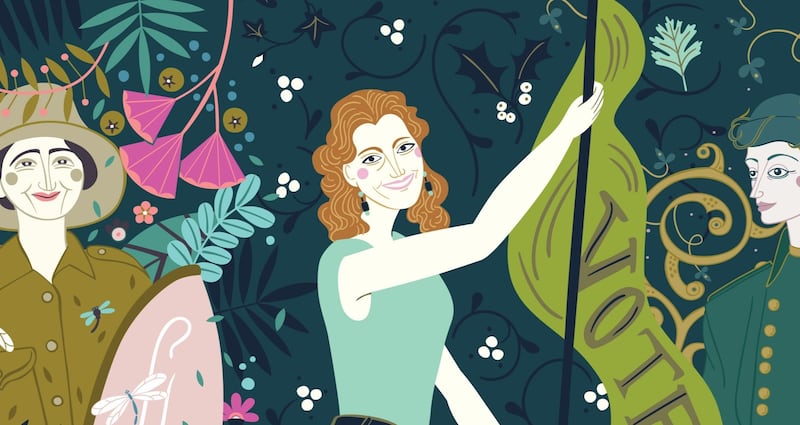Eva Selina Gore-Booth (1870-1926), poet, mystic, trade unionist and suffragist, was born on May 22nd, 1870, at Lissadell in Co Sligo, the second of three daughters (and two sons) of Sir Henry Gore-Booth, fifth baronet and Arctic explorer, and his wife, Georgina (nee Hill), of Tickhill Castle, in Yorkshire.
Only two years younger than her famous sister, Constance Markievicz, Eva was quieter and more reserved and, even as a child, displayed an interest in the mystical. To Sarah Purser, who painted Eva and Constance as children, she was the more sensitive of the sisters.
As prominent but conscientious landlords, the Gore-Booths helped to distribute relief during the famine of 1879, and these early experiences may have stimulated Eva in her lifelong commitment to the poor.

WB Yeats eloquently recorded his visits to Lissadell and the extraordinary life of the sisters he remembered in silk kimonos
Her upbringing was fairly typical of her class; thanks to her Cambridge-educated governess she was knowledgeable in Latin and Greek as well as English, French and German literature. But, although she was presented at court, she showed little interest in fashionable society.
Having visited the Caribbean and North America with her father in 1894, she made a continental tour in 1895, partly to improve her weak constitution. While in Italy in 1896 she met Esther Roper, a Manchester-based social activist and suffragist, with whom she formed an immediate and lifelong friendship.
On returning to Ireland she worked alongside her sisters, Constance and Mabel, in the running of the Sligo branch of the Irish Women’s Suffrage and Local Government Association.
Her family entertained lavishly, and the poet WB Yeats eloquently recorded his visits to Lissadell and the extraordinary life of the sisters he remembered in silk kimonos (In memory of Eva Gore-Booth and Con Markievicz).
By 1897 she had settled in Manchester with Roper. The years that followed marked the beginning of her career as a social campaigner and her emergence as a significant contributor to the Irish literary revival.
Through her association with Andrew Lang her poetry first appeared in Longman's Magazine, and in 1898 her first volume, Poems, was published. It conformed to the Celtic Twilight style and was warmly received by Yeats, who commented on its "poetic feeling" and "great promise". She went on to contribute to numerous periodicals, among them the New Irish Review, Irish Homestead, the Savoy and the Yellow Book.
Her social work focused primarily on the concerns of women. In 1898 she and Roper became joint secretaries of the Women’s Textile and Other Workers Representative Committee, and in 1900 she became cosecretary, with Sarah Dickenson, of the Manchester and Salford women’s trade-union council. As a member of the Manchester city council’s technical-instruction committee she fought against the exclusion of girls from scholarships in the Municipal College of Technology.
This concern in educational matters resulted in her involvement in the Manchester University Settlement, from where she ran popular drama and poetry groups for women workers.
Editor of the Women's Labour News, and a contributor to the NUWSS paper the Common Cause, she also produced several pamphlets on women's issues, including Women Workers and Parliamentary Representation (1904) and Women's Right to Work (1908). She addressed meetings and organised workers throughout England, and regularly joined deputations to cabinet ministers and MPs.
After the 1916 Rising Gore-Booth travelled to Dublin and was instrumental in campaigning for the reprieve of her sister's death sentence and improvement of her prison conditions
Throughout her career she assisted such diverse groups as pit-brow workers, women acrobats, barmaids and Oxford Circus flower sellers. A member of the executive committee of the North of England Society for Women’s Suffrage, she believed strongly in linking the suffrage question to women’s trade unionism.
She and Roper gathered 30,000 signatures for one suffrage petition in 1901, and her involvement in the campaign led her to befriend Christabel Pankhurst in 1901. Booth and Roper encouraged Pankhurst to study law, but as Pankhurst pursued a more militant and high-profile course within the suffrage movement, she became alienated from them.
A prolific writer, Gore-Booth was included in George Russell's 1903 anthology New Poems: A Lyric Selection with AE, and her best-known work, The Little Waves of Breffny, appeared in The One and the Many (1904). This was followed by volumes including The Egyptian Pillar (1907), in which she examined Christian mysticism and Islamic themes, and The Agate Lamp (1912).
Of her plays, which often drew on themes from the Ulster Cycle, Unseen Kings was produced by her sister for the Independent Theatre Company in 1911, following a rejection from the Abbey Theatre.
Poor health forced her to leave Lancashire, and in 1913 she and Roper moved to London. For the duration of the first World War she was actively involved in the Women’s Peace Crusade and the No-Conscription Fellowship, and she supported conscientious objectors.
After the 1916 Rising she travelled to Dublin and was instrumental in campaigning for the reprieve of her sister's death sentence and improvement of her prison conditions. Although Constance had kept her sister's numerous letters to her, these were accidentally destroyed and could not be included in Roper's Prison Letters of Constance Markievicz (1934).
She attended the trial of Roger Casement and lobbied for a stay of execution; later she campaigned against capital punishment and for prison reform. In her last years she studied Greek, the scriptures and theosophy, and these interests are reflected in much of her later writings. An enthusiastic painter, she was for many years a strict vegetarian, and a supporter of animal rights.
After a prolonged struggle with cancer she died on June 30th, 1926, in Hampstead, in London, where she was buried alongside Esther Roper. At the time of her death, Constance described to Roper how the telepathic communication with her sister had so comforted her during her imprisonment. Her Collected Poems was published in 1929.
From the Royal Irish Academy Dictionary of Irish Biography, published by Cambridge University Press

















